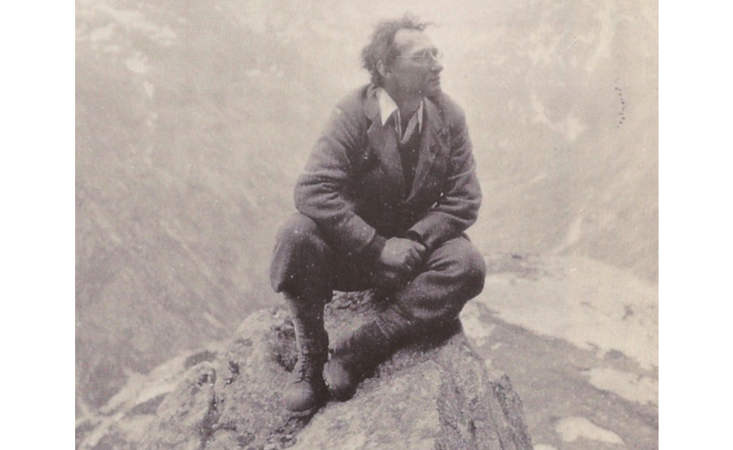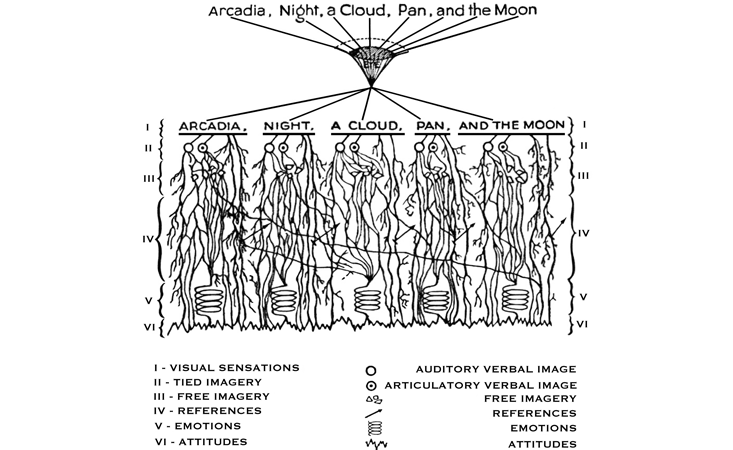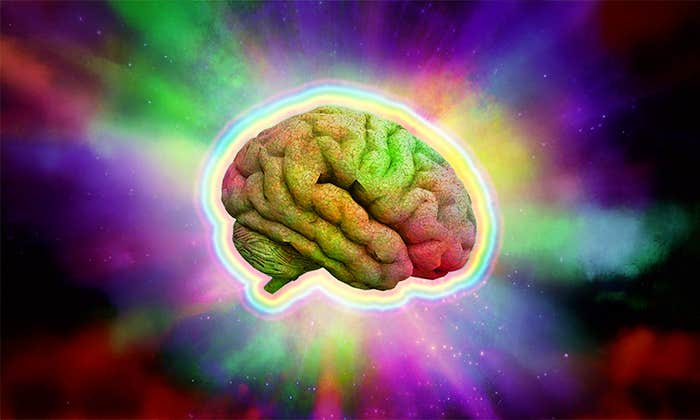In the 21st century, neuroscience has been able to extend our understanding of the brain beyond brain anatomy to an increasingly functional view of cognition. Every year brings new insights on memory and imagination, and reveals often surprising areas of convergence with fields such as anthropology and philosophy. Yet it was a Cambridge professor of literature, almost a century ago in the aftermath of World War I, who pioneered a view of cognition we can recognize as strikingly modern, and who appreciated what we are only now beginning to rediscover: the great potential of interactions between the narrative arts and brain science.
At the opening of the 20th century, such interdisciplinarity was resisted. Academic culture was defined by specialists in silos. One who refused to be confined was English critic I.A. Richards. A tubercular child who missed several years of school, Richards’ idea of recovery was to dedicate himself to mountaineering, spending much of his undergraduate career free-climbing the spires and turrets of his college at Cambridge. With his wife Dorothy Pilley, Richards ascended peaks in the Alps and elsewhere, such as those in Montana’s Glacier National Park.

An advocate of the empirical study of literature, Richards thought of himself as an “inventor” more than a critic. In his groundbreaking Principles of Literary Criticism, published in 1924, Richards laid out a perspective which was deeply unsettling to his contemporaries: “a book is a machine to think with.” Richards brought neurobiological perspectives to an understanding of our literary mind in an era when historical and biographical criticism was the norm, and the teaching of literature remained based on grammar and rhetoric. Indeed, he was thinking so far beyond the literary criticism and science of his day that we are still catching up.
With Principles of Literary Criticism and its follow-up, Practical Criticism, Richards argued literature should be studied in its own right. Reputedly, his lectures at the School of Literature at Cambridge in the 1920s were so popular they had to be held in the streets. He advocated the “close reading” of texts, attending to sensory and emotional specificity and the play of ambiguity. This attitude became the hallmark of a new group that included Richards and his students, William Empson and F.R. Leavis, who became known as “New Critics.” But science—in particular neuroscience—also became involved at this vital juncture.
He was thinking so far beyond the literary criticism and science of his day that we are still catching up.
This was due to an extraordinary proposal made by Richards. In Principles of Literary Criticism, he asserted that to establish an effective critical stance, one had to base it upon a view of the mind, identifying the mental state created by a work of art. His description of what is required of the critic was phrased in terms that would not sound out of place in a neuroscience discussion today.
Richards argued that we have a need for “a schema of the mental events which make up the experience of ‘looking at’ a picture or ‘reading’ a poem.” Perhaps even more surprising, Richards delivered a highly delineated description, a compact conjectural map, of the mental steps involved in reading and interpreting a poem. Richards’ thinking was broad, encompassing the physiological processes of reading as well as the psychological processes of reader response. His model emerged in a period when the school of thought dominating psychology was behaviorism, which explicitly rejected analysis of what was going on inside the organism, or the brain, in favor of the study of overt behavior. Mental imagery and imagination lay well outside the range of the behaviorists’ own theoretical maps.
Richards’ “hieroglyph” as he humorously dubbed it, suggested that images of words on a page are projected from the eyes to a system of repeating modular units in the brain that perform sequential operations in response to them; for example, evoking images, or emotions. While Richards stressed his sketch was not meant to be “a picture of the nervous system,” it was clearly inspired by information about neural architecture. The elements within his modular units are reminiscent of nerve cells. Indeed, the whole structure is suggestive of what was then known about the functional organization of the outer layers of the cerebrum: the cortex (which has six recognized layers, even designated I-VI as in Richards’ model).

Richards’ model shows a line from a poem by Robert Browning, digested for meaning one word at a time. Recent research confirms this is a generally accurate depiction of how we read: A sentence is not comprehended all at once or even in a smooth stream; rather, our eyes make a series of jumps, called saccades, across the lines of text. As they alight briefly, the eyes acquire the image of a group of letters roughly equal to one word and then immediately jump farther along, pausing to sample another word or two. That such eye movements underlie comprehension has been known since the work of psychologists such as E.B. Huey in the early 1900s. Clearly, Richards was incorporating the best available experimental knowledge of the time. Even now, the complexities of eye movements continue to inform our understanding of reading dynamics, cognition, and literacy.
Most striking are the mental functions specified in Richards’ model, really a set of steps that comprise our cognitive reactions to text. The brain first responds to the visual sensation of clusters of letters (layer I). This is followed by the elicitation of imagery in multiple modalities (II and III) and stored associations, triggered by words or phrases (IV). Layers II–IV might be best interpreted as calling up things remembered or imagined, whereas the final layers (V and VI) relate to the evocation of emotions and attitudes. Richards’ conjectured dynamics, in which the serial processing of word images blends with the early involvement of memory and emotion, is consistent with current psychology and neuroscience.1
So where did this amazing model come from? Richards acknowledged later in life that it was inspired by the ideas of a neuroscientist: Charles Scott Sherrington. In the course of a long and illustrious career, Sherrington coined the terms “synapse” (the functional connection between neurons) and “proprioception” (the brain’s sense of the state and position of the body), with publications on reflexes as fundamental sensorimotor mechanisms, and the structural organization of the primate cerebral cortex. He was awarded the Nobel Prize in 1932.
Richards laid out a deeply unsettling perspective to his contemporaries: “A book is a machine to think with.”
Sherrington had been a student, then a fellow, at Cambridge before 1900. His legacy was deep and well known to Richards, who arrived there in 1912. The profound imprint of Sherrington’s neurophysiology is evident in the overall form of Richards’ model and the language he used to describe it, outlining the competing “impulses” flowing through the system, and the resultant states of “equipoise,” or balance, between them. This closely paralleled Sherrington’s sense of the feedback between neural pathways when rival signals—positive (excitatory) and negative (inhibitory)—are integrated to ensure coordinated control of posture and movement. Richards’ model incorporated the latest neurological thinking of his time, but went beyond to draw connections to full cognitive engagement with literature. With typical irreverence, he was later to tell his biographer that he “just translated Shelley into Sherrington.”2 It’s a revelation that neuroscience was there at the birth of modern literary theory.
Richards’ early foray into neurophysiology foreshadowed to a remarkable extent other recent discoveries about the processes behind reading. He emphasized the importance of memory for the critical reception of all arts because “there is no kind of mental activity in which memory does not intervene,” sounding very modern indeed. Further, his work was current when Frederick Bartlett was conducting his classic studies (1932) in which he was able—from following people’s ability to recall elements of stories—to show that memories are not “snapshots in time,” but rather narrative constructions. Even more recently, it has been noted that Richards’ ideas on cognition in 1924 were a form of “proto” connectionism in which memory was not based on fixed, archive-like properties, but instead was based on non-symbolic and distributed forms of representation.3
As a critic, Richards was fascinated with the role of imagination in literary reception, suggesting profound connections between it and memory. He wrote that “imaginative construction is always at least as much determined by what is going on in the present, as by what went on in the past, pasts rather, whence it springs.” One of the most intriguing and productive insights of psychology and neuroscience in the early 21st century has added substance to Richards’ intuition. By 2007, several neural and psychological studies showed that memory and imagination are indeed highly related processes, both occurring in multiple forms—some implicit, some explicit—and both are highly constructive. Moreover, remembering past events and imagining future ones share similar cognitive network space within the brain.4
Richards also had a lifelong interest in how meanings are established from words and phrases, with an early co-written volume cheekily entitled The Meaning of Meaning (1923). Here again he was ahead of what the technology of the time could achieve. Recent neuroscience has confirmed his intuition that reading-derived semantic information is stored widely across the cerebral cortex and, like an atlas, word relationships appear to be clustered there by a modest number of categories of knowledge.5
We are now at the point where it is even possible to follow the synchronous “ticking” of several brains at once, indicating the more or less orchestrated consistency of responses to story features, and how the degree of temporal coupling between brains correlates with more effective communication. Multi-brain neuroscience offers real hope for a more empirical understanding of narratives in their natural context: as they resonate between an author and a reader, or a storyteller and an audience.6
We are a storytelling species, every bit as much as a tool-using one, so it’s perhaps fitting that insights from the narrative arts keep pressing their claims on neuroscience. Ingenious experiments are casting new light on what it means to hear a fictional character speak, feel their emotion, visualize an invented scene, or experience a story world. Narratives provide a rich and ever-more accessible cognitive terrain for literary creativity, virtual play, and serious analysis. Brain science is now mapping that terrain and has much to share with, and much to learn from, the humanists who got there first, especially I.A. Richards.
Christopher Comer is coauthor of Brain, Mind, and the Narrative Imagination. He is emeritus professor of biology and neuroscience at the University of Illinois at Chicago and the University of Montana, and has been dean of the College of Humanities and Sciences at UM and at UIC.
Ashley Taggart is coauthor of Brain, Mind, and the Narrative Imagination. He is a lecturer in drama at University College Dublin. He has also been a script editor and screenwriter for many years; his most recent documentary is The Irish Woman Who Shot Mussolini.
This article is adapted from Brain, Mind, and the Narrative Imagination, by Christopher Comer and Ashley Taggart (Bloomsbury Press, 2021).
References
1. Marinkovic, K. Spatiotemporal dynamics of word processing in the human cortex. The Neuroscientist 10, 142-152 (2004); Dehaene, S. Reading in the Brain: The New Science of How We Read Penguin Books, London (2009); Oatley, K. Such Stuff as Dreams: The Psychology of Fiction Wiley-Blackwell, West Sussex, U.K. (2011).
2. Russo, J.P. I.A. Richards: His Life and Work Routledge, New York, NY (1989).
3. Jones, G.V. A protoconnectionist theory of memory. Memory & Cognition 21, 375-378 (1993).
4. See, for example: Schacter, D., et al. The future of memory: Remembering, imagining, and the brain. Cell 76, 677-694 (2012).
5. Huth, A.G., de Heer, W.A., Griffiths, T.L., Theunissen, F.E., & Gallant, J.L. Natural speech reveals the semantic maps that tile human cerebral cortex. Nature 532, 453-458 (2016); Deniz, F., Nunez-Elizalde, A.O., Huth, A., & Gallant, J. The representation of semantic information across human cerebral cortex during listening versus reading is invariant to stimulus modality. The Journal of Neuroscience 39, 7722-7736 (2019).
6. Stephens, G.J., Silbert, L.J., & Hasson, U. Speaker-listener neural coupling underlies successful communication. Proceedings of the National Academy of Sciences 107, 14425-14430 (2010); Schoot L, Hagoort P, & Segaert K. What can we learn from a two-brain approach to verbal interaction? Neuroscience & Biobehavioral Reviews 68, 454-459 (2016).
Lead image: Sergey Nivens / Shutterstock


























